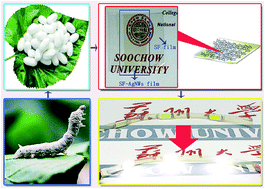Highly flexible and conductive composite films of silk fibroin and silver nanowires for optoelectronic devices
Abstract
Silver nanowire-coated silk fibroin (SF) was used to create composite films with high flexibility, good electrical conductivity and excellent mechanical properties. SF was coated with a layer of entangled silver nanowires (AgNWs) that were sputtered with a platinum layer. The SF–AgNWs composite films exhibited excellent performance with a conductivity of ∼15.0 Ω sq−1 and transmittance of ∼80% in the visible light range. The films also retained conductivity even after being bent hundreds of times; this recovery was attributed to the structure of the embedded AgNWs in SF, and metallic contacts among the AgNWs induced by the ion sputtering. The SF–AgNWs composite films also showed promise in practical applications, including as a conduit to light emitting diodes (LEDs). These novel composite films could be used to fabricate wearable electronics and implantable devices.


 Please wait while we load your content...
Please wait while we load your content...